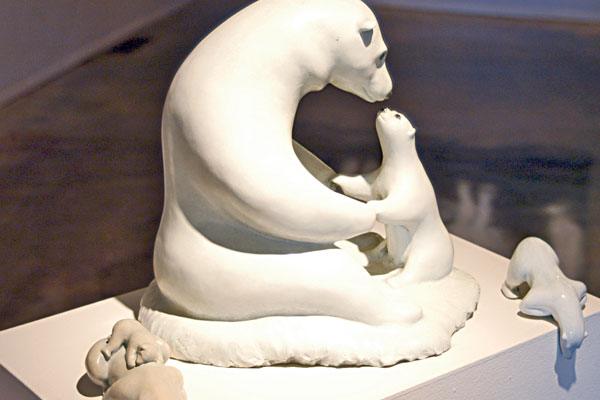Define the term “safe harbor.”
In the classical sense, a safe harbor is a sheltered port where ships can take on or discharge cargo. But in a world where a rainbow of colors separates black and white, so many other definitions exist.
A mother polar bear with its cub … a bearded man snuggling a small child … a lone rowboat approaching a small wooded island ….
Thirty-seven artists from all over the Pacific Northwest defined “safe harbor” and will share their creative evaluations at the Port Angeles Fine Arts Center, 1203 E. Lauridsen Blvd., 11 a.m.-
5 p.m. Wednesday-Sunday through Oct. 10.
“In an age where new threats captivate mass consciousness without pause, the theme of ‘Safe Harbor’ is especially ripe for a broad range of interpretations, many of which have no direct connection to marine moorage yet maintain a metaphoric link to the sea,” said curator Jake Senuik.
“We offered the rubric ‘safe harbor’ as a catalyst to launch artists’ exploration and we received responses from 70 creators employing a variety of media. Given the limits of our exhibition space, the short timeline leading up to the show and the vastness of the theme, we have no doubt just begun to scratch the surface of this deep notion that is ‘Safe Harbor.’”
Photographer David Woodcock, of Sequim, submitted aerial views of the Olympic Peninsula. A low-flying perspective of Crescent Bay reveals a classic safe harbor in contrast to a second photograph highlighting a truce between the city of Port Angeles and the cool blue waters of the ocean.
Kiefer Klein, of Port Angeles, created a miniature gypsy wagon replica filled with pictures and mementos of her grandmother.
“That’s exactly what a gypsy wagon is,” Klein said, “a safe harbor.”
Klein spent many sum-mers at her grandmother’s house in Chicago and describes the elderly gypsy woman as “a very fascinating person.”
Jeffree Stewart, an ecologist and artist from Olympia, is guilty of mixing business with pleasure. His work with the city of Port Angeles and Clallam County on a harbor management plan and shoreline master plan inspired a series of vibrantly colored oil paintings.
“It’s a very timely subject,” Stewart said safe harbors.
Not all of the pieces on display are “beautiful” or “happy,” Senuik warned.
Some portray the negative aspects associated with a safe harbor, such as Seattle artist Polly Purvis’ display of vintage glass laboratory equipment suspended from the ceiling and filled with contaminants such as fluorescent antifreeze, black motor oil, white plastic grocery bags and specimens of poisoned tidal plants and pollutant disfigured marine life.
“How do we know a harbor is safe if we don’t address the dangers?” Senuik probed.
Another submission, by Seattle artist Iskra Johnson, presents a series of mixed-media drawings depicting female suicide bombers, with one asking the question in its title, “What Does Heaven Look Like?”
A complete description of the exhibit and an essay written by Senuik is available online at www.pafac.org.



